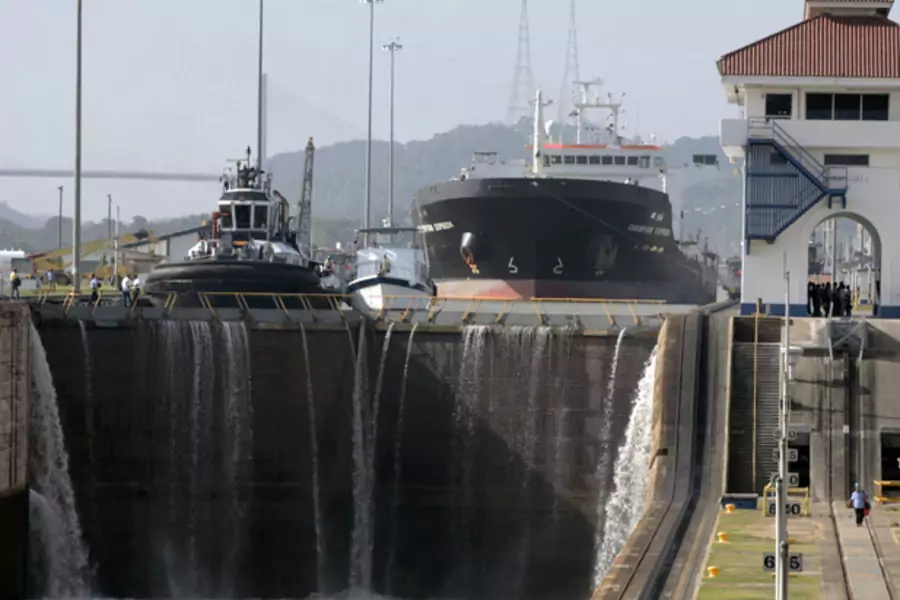Policy Initiative Spotlight: Teddy’s Big Ditch Grows Deeper

More on:
This summer, a billion-dollar project will begin to raise the road deck of the Bayonne Bridge that links Staten Island to Jersey City, and provides access to Manhattan via the Holland Tunnel. The project is not being undertaken because of safety concerns about the current bridge, but rather to allow larger container ships to pass underneath it and reach the Port of New York and New Jersey. It’s just one of several port projects in anticipation of the widening of the Panama Canal.
By early 2015, the Panama Canal is scheduled to complete a $5.25 billion expansion project that began in 2007 to widen and deepen existing navigational channels to allow larger ships to traverse the isthmus, and construct new sets of locks to increase capacity.
The scale of global trade has increased remarkably since Theodore Roosevelt championed the U.S. effort to build the canal. From 1915 to 2012, tonnage to cross the 48-mile link increased from 5 million to 334 million. Today, the largest ships that can cross the isthmus are the so-called panamax vessels that can carry 4,500 shipping containers. The expansion project—the largest undertaken since the canal opened in 1914—will allow post-panamax vessels carrying nearly three times that cargo to make that journey.
It’s an important development for global commerce. Post-panamax ships have lower shipping costs; per container costs are more than 50 percent less than a panamax ship. While post-panamax vessels account for only 16 percent of the global container fleet, they already carry 45 percent of cargo, with those shares projected to respectively grow to 27 and 62 percent by 2013.
Analysts say the canal's expansion will be a particular boon to the shipment of liquefied natural gas (LNG). LNG tankers are too large to pass through today’s Panama Canal. With the Sabine Pass LNG export terminal expected to open in Louisiana in 2015, and other terminals proposed, the expansion project is well-timed to aid the flow of natural gas from shale fields in the United States to Asian energy markets where the price for this resource is several times higher. Some experts estimate the canal expansion could reduce shipping costs on this route by $1 per million BTU.
CFR Senior Fellow Michael Levi explained the benefits of a wider Panama Canal to LNG trade in a study published last year with the Brooking Institution’s Hamilton Project: “LNG tankers departing the Gulf of Mexico or the East Coast of the United States currently need to travel all the way around South America to reach Asia, adding considerable cost to their trips and eroding potential gains from trade.”
The project has also prompted intranational competition. Los Angeles/Long Beach (LA/LB) is the nation’s largest port, handling 40 percent of U.S. cargo traffic. But with the canal expansion, eastern ports could potentially take up to a quarter of LA/LB’s business, so the port authority has planned $6 billion of upgrades, part of the $46 billion in upgrades to U.S. ports funded by public or private sources over the next five years.
Today, just four U.S. ports are ready for post-panamax ships: Norfolk in the east and LA/LB, Oakland, and Seattle in the west. Colliers predicts another four will be post-panamax ready by 2015: Baltimore, New York, Miami, and Houston. The infrastructure investments at these ports and others such as Charleston, Savannah, and New Orleans, range from dredging waterways and adding cranes, to preparing intermodal support networks, including railways modifications for the increased height of double stacked containers.
The raising of the Bayonne Bridge is one of seven port projects the Obama administration announced it would help expedite last summer, the first set of more than 40 infrastructure projects to be fast-tracked for review by executive order. The president said the "commitment to move these port projects forward faster will help drive job growth and strengthen the economy."
Still, Robert Puentes, a transportation expert at the Brookings Institution stressed the need for greater federal leadership on this issue, perhaps in developing a comprehensive freight policy like many other nations. “I can’t see the federal government picking winners and losers” he said in a New York Times interview, but “they could provide a little more guidance — where right now they are providing none.”
More on:
 Online Store
Online Store